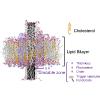当前位置:
X-MOL 学术
›
Phys. Rev. Lett.
›
论文详情
Our official English website, www.x-mol.net, welcomes your feedback! (Note: you will need to create a separate account there.)
Unexpected Cholesterol-Induced Destabilization of Lipid Membranes near Transmembrane Carbon Nanotubes.
Physical Review Letters ( IF 8.6 ) Pub Date : 2020-01-24 , DOI: 10.1103/physrevlett.124.038001 Yachong Guo 1 , Marco Werner 2 , Jean Baptiste Fleury 3 , Vladimir A Baulin 4
Physical Review Letters ( IF 8.6 ) Pub Date : 2020-01-24 , DOI: 10.1103/physrevlett.124.038001 Yachong Guo 1 , Marco Werner 2 , Jean Baptiste Fleury 3 , Vladimir A Baulin 4
Affiliation

|
Cholesterol is a crucial component of mammalian cell membranes that takes part in many vital processes. It is generally accepted that cholesterol stabilizes the membrane and induces transitions into ordered states. In contrast to expectations, we demonstrate that cholesterol can destabilize the membrane by creating a nanodomain around a perpendicularly embedded ultrashort carbon nanotube (CNT), and we show that cholesterol triggers the translocation of an ultrashort CNT through the cell membrane. Using atomistic simulations, we report the existence of a nanoscale domain around an ultrashort carbon nanotube within a crossover distance of 0.9 nm from the surface of the nanotube, where the properties of the bilayer are different from the bulk: the domain is characterized by increased fluctuations, increased thickness, and increased order of the lipids with respect to the bulk. Cholesterol decreases the thickness and order of lipids and increases the fluctuations with respect to a pure lipid bilayer. Experimentally, we confirm that cholesterol nanodomains provoke spontaneous translocation of nanotubes through a lipid bilayer even for low membrane tensions. A specially designed microfluidic device allows us to trace the kinetic pathway of the translocation process and establish the threshold cholesterol concentration of 20% for translocation. The reported nanoscale cholesterol-induced membrane restructuring near the ultrashort CNT in lipid membranes enables precise control and specific targeting of a membrane using cholesterol. As an example, it may allow for specific targeting between cholesterol-rich mammalian cells and cholesterol-poor bacterial cells.
中文翻译:

跨膜碳纳米管附近的脂质膜意外胆固醇诱导的失稳。
胆固醇是哺乳动物细胞膜的重要组成部分,参与许多重要过程。人们普遍认为胆固醇可以稳定膜并诱导转变为有序状态。与预期相反,我们证明胆固醇可以通过在垂直嵌入的超短碳纳米管(CNT)周围形成纳米域来破坏膜的稳定性,并且我们证明胆固醇触发超短CNT通过细胞膜的转运。使用原子模拟,我们报告了在距碳纳米管表面0.9 nm的交叉距离内,超短碳纳米管周围存在纳米级畴,该双层的特性与本体不同:该畴的特征是波动增加,增加厚度,以及脂质相对于主体的顺序增加。胆固醇降低了脂质的厚度和顺序,并增加了相对于纯脂质双层的波动。在实验上,我们确认胆固醇纳米域即使在膜张力低的情况下,也会通过脂质双层激发纳米管的自发移位。经过特殊设计的微流控设备使我们能够追踪易位过程的动力学路径,并确定易位的胆固醇阈值浓度为20%。脂质膜中超短CNT附近已报道的纳米级胆固醇诱导的膜结构重建,可使用胆固醇精确控制和特异性靶向膜。例如,它可以允许在富含胆固醇的哺乳动物细胞和缺乏胆固醇的细菌细胞之间进行特异性靶向。
更新日期:2020-01-23
中文翻译:

跨膜碳纳米管附近的脂质膜意外胆固醇诱导的失稳。
胆固醇是哺乳动物细胞膜的重要组成部分,参与许多重要过程。人们普遍认为胆固醇可以稳定膜并诱导转变为有序状态。与预期相反,我们证明胆固醇可以通过在垂直嵌入的超短碳纳米管(CNT)周围形成纳米域来破坏膜的稳定性,并且我们证明胆固醇触发超短CNT通过细胞膜的转运。使用原子模拟,我们报告了在距碳纳米管表面0.9 nm的交叉距离内,超短碳纳米管周围存在纳米级畴,该双层的特性与本体不同:该畴的特征是波动增加,增加厚度,以及脂质相对于主体的顺序增加。胆固醇降低了脂质的厚度和顺序,并增加了相对于纯脂质双层的波动。在实验上,我们确认胆固醇纳米域即使在膜张力低的情况下,也会通过脂质双层激发纳米管的自发移位。经过特殊设计的微流控设备使我们能够追踪易位过程的动力学路径,并确定易位的胆固醇阈值浓度为20%。脂质膜中超短CNT附近已报道的纳米级胆固醇诱导的膜结构重建,可使用胆固醇精确控制和特异性靶向膜。例如,它可以允许在富含胆固醇的哺乳动物细胞和缺乏胆固醇的细菌细胞之间进行特异性靶向。



























 京公网安备 11010802027423号
京公网安备 11010802027423号